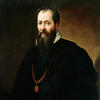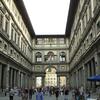More about Portrait of Alessandro de' Medici

Sr. Contributor
You can’t read into this one too much. Giorgio Vasari filled his Portrait of Alessandro de' Medici with so much symbolism and iconography he sent the completed portrait with a letter explaining them all.
The Medici family were fans of Vasari, and he’d just done a portrait of Lorenzo the Magnificent - which also was filled with iconography and came with a letter - before being commissioned to paint this portrait for the Duke of Florence, Alessandro de' Medici. Liking this piece so much and enjoying how much his emblem-filled paintings supported their image as propagators of peace, The family had Vasari stay on as the court painter for the Duke.
Some of Vasari’s symbolism isn’t hard to figure out. For instance, the red cape that’s meant to represent the blood of his fallen enemies is classic stuff. Then you have the burning helmet that’s specifically on the floor and not worn by Alessandro to represent his peace in governance and everlasting reign of friendship. You've likely guessed Vasari was a bit of a perfectionist; apparently, trying to get the detail of the armor’s luster just right proved so difficult it almost drove him mad until a lesson in illusionism helped him out.
The name “Medici” likely sounds familiar, probably because they were a powerhouse ruling family in Italy for generations. But they weren’t always in power, and definitely were not always well liked. Alessandro has two potential dads; he was born to a servant, so he’s thought to be the son of either Lorenzo, Duke of Urbino, or his nephew Giulio de’ Medici, better known as Pope Clement VII. Either way, Alessandro rose to power as a Duke and had to deal with the misfortune that befell Pope Clement VII.
In a nutshell, Pope Clement VII was the one who told Henry VIII "no" on his marriage, causing the Catholic Church to separate from England. Shortly thereafter, he didn’t acknowledge Emperor Charles V’s power in order to focus on repairing relations with the French. After Emperor Charles V defeated the French army and didn’t have any money to pay his own forces, the angry soldiers said "fine," we’ll get our wages out of Rome…by completely sacking the city and forcing the Pope to flee. At the same time, a revolution broke out in Florence and the Medici family fled. A couple years later, The Pope and Emperor were on good terms and he agreed to restore their family to power. After a long siege, the Emperor’s army took back Florence and installed Alessandro in power. All of this history is alluded to in Vasari’s portrait. What’s not alluded to is Alessandro’s less heroic side that led to his downfall.
It’s said Alessandro won over his subjects with his sense of justice and worked hard in rebuilding Florence…but he was also, at best, a sexual deviant. So while he was bringing a city torn apart by war back to life, he was also trying to sleep around as much as possible. He had a helper in this named Lorenzino de’ Medici, his cousin who would arrange his "licentious amusements.” Lorenzino took advantage of Alessandro’s trust and murdered him in the middle of the night. Based on the confession letter left behind by a Bishop, Lorenzino wasn’t the only one who wanted Alessandro dead. He had a rival heir who was positioned to take Florence named Ippolito de’ Medici...but he also got murdered. Poisoned, presumably at Alessandro’s request. Oh, and then Lorenzino was also murdered. It’s a wonder the Medici stayed in power at all since they were so busy killing each other!
After Alessandro died, Vasari decided he was done with the life of a court painter and left to pursue his art independently. Can hardly blame him, he originally caught Alessandro’s attention with his painting Entombment that was commissioned by Ippolito. Fleeing from more potential blood feuds was likely his best business decision.
Sources
- "Alessandro." Encyclopædia Britannica. Accessed January 19, 2022. https://www.britannica.com/biography/Alessandro.
- Bartlett, Kenneth R. A Short History of the Italian Renaissance: Kenneth R. Bartlett. Toronto: University of Toronto Press, 2013.
- Cheney, Liana De Girolami. Giorgio Vasari's Teachers: Sacred & Profane Art. New York: P. Lang, 2007.
- "Clement VII." Encyclopædia Britannica. Accessed January 19, 2022. https://www.britannica.com/biography/Clement-VII-pope.
- "Ippolito De' Medici." Encyclopædia Britannica. Accessed January 19, 2022. https://www.britannica.com/biography/Ippolito-de-Medici.
- Kliemann, Julian. Giorgio Vasari: Kunstgeschichtliche Perspektiven. 1991.
- "Portrait of Alessandro De' Medici by Giorgio Vasari: Artworks: Uffizi Galleries." Uffizi Galleries. Accessed January 19, 2022. https://www.uffizi.it/en/artworks/vasari -alessandro-portrait.
- Rubin, Patricia Lee. Giorgio Vasari: Art and History. New Haven: Yale University Press, 1995.











